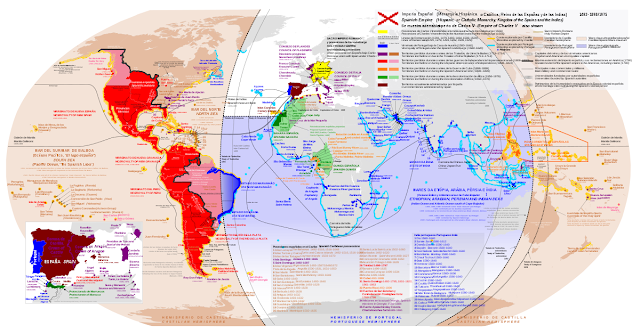 |
| Holy Roman Emperor Charles V in armor. |
(Profiles: Carlos I / Charles V.)
 |
| Map of Spanish Empire and Empire of Charles V. |
Much of the European territory was acquired not by war but by marriage, a marital rather than martial takeover spanning generations.
Charles was the son of Juana I la Loca (Joanna the Mad) and grandson of Ferdinand II of Aragon and Isabella I of Castile, the monarchs who first backed Christopher Columbus. Charles's father was Philip I of Castile, who was the son of Holy Roman Emperor Maximilian I and Mary of Burgundy.
Magellan approached Charles to sell his plan to seek a westward route to Asia. Columbus, too, had first approached a Portuguese monarch for backing, but Portugal at that time had just discovered how to round the southern tip of Africa and stayed focused on that route.
Till his death, Columbus insisted he had discovered not some new world but had in fact reached east Asia, but soon more landings in South and Central America were beginning to outline a continent. Then in 1513, the Spanish explorer Vasco Núñez de Balboa crossed the Panama Isthmus and became the first European to lay eyes on the Pacific Ocean, which he named the South Sea.
Between 1505 and 1512, Magellan had served Portugal as a soldier in East Africa and India and fought in the Portuguese invasion of Malacca in 1511. After Manuel declined to back him, Magellan defected to Spain, where he used his seven years of Asian experience to promote the westward expedition. He provided Charles with maps, documents, and people—Enrique of Malacca, a slave Magellan captured or bought following the sack of the city, who was talented with languages, and possibly also a young women from Malacca or Java. The meeting was held in Valladolid. (It's likely that Enrique, a Malay teenager, spoke much better Spanish than Charles at the time.)
Spanish officials were horrified to learn that their king was backing a Portuguese captain and several worked hard to sabotage Magellan’s preparations. The Flemish Charles remained steadfast though—he knew well of the revenue pouring into Lisbon and he needed money himself.
As Mark Twain noted, dates mean a lot more when put in the context of other contemporary events. When all this was happening, the Renaissance was in high gear, but medieval thinking was still widespread. The Spanish Inquisition was established only decades earlier in 1478 by Ferdinand and Isabella, and Constantinople had fallen to the Ottoman Turks only seventy years earlier, in 1453, ending the thousand-year-old Byzantine Empire, itself an extension of Rome.
Meanwhile, the Protestant Reformation had just gotten under way, and in England, Henry VIII was still on wife number one, Catherine of Aragon, an aunt of Charles V.
By: John Sailors, Enrique's Voyage.
Images
• Charles V in armor: Juan Pantoja de la Cruz, Public domain, via Wikimedia Commons.
• Spanish Empire and Empire of Charles V. : Nagihuin, CC0, via Wikimedia Commons
(C) 2022 by Enrique's Voyage. All rights reserved.

